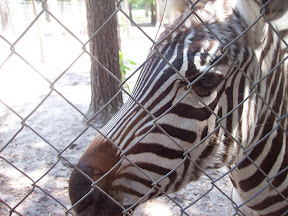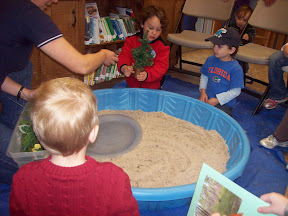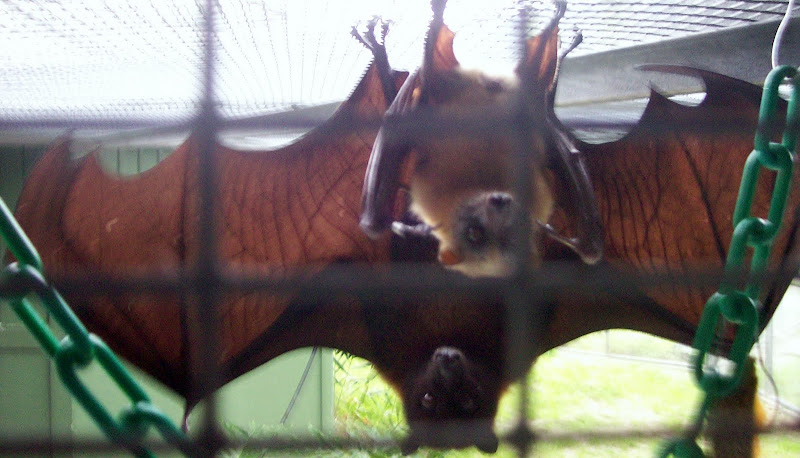K captured some grasshoppers and K and J observed them for about an hour this afternoon. They read about the various sources of food for grasshoppers and also what part they play in the food chain for other animals.
Today, we read Oil Spill by Melvin Berger, A stage 2 science book that talked about the Exxon Valdez oil spill, the effects of the spill on wildlife, and the various causes and methods of containment for an oil spill. After reading the book, we reviewed a map of the Gulf of Mexico and discussed the oil rig sinking and oil leak off of the Mississippi Del;ta. We talked about the spread of the oils pill and how currents, which we learned about in Paddle to the Sea, will draw the spill around Florida to its East Coast. We then talked about ways to rescue wildlife and performed a science experiment to see how dish-washing detergent repels oil. We also discussed the different methods used to try and cap or stop the continuing stream of oil under the ocean.
Wednesday, May 5, 2010
Tuesday, May 4, 2010
Saturday, May 1, 2010
May 1, 2010
Discussed the boys' goals in Paddle to the Sea and drew pictures representing our dreams to send for the unveiling of the Paddle to the Sea park in Nipigon, Ontario.
Wednesday, April 28, 2010
Two Tails Ranch
[taken in part from a friend's blog]
15 miles south of Gainesville in Williston is a large animal rescue/sanctuary, the Two Tails Ranch. We went there this week with our home school group to see elephants, zebras, giant tortoises, tigers, ostriches and more.
It turns out that the reason she was “dancing” is because elephants are so heavy, they have to stay in constant movement or their organs will become crushed under their own weight. This is also why they sleep standing up; lying down for more than 20-30 minutes causes fluid to build up in their lungs. Amazing.
The elephants at Two Tails are all Asian elephants, distinguished from their African cousins by smaller ears, lighter skin, no tusks for the females, two domes on the head instead of one, and a difference in toe count. The lighter skin pigment includes freckles, as see on this female’s face:

The information given was rather sobering. Unless current bans on importing elephants to the US are lifted and intensive breeding programs are implemented, these endangered animals will likely be extinct in the next 75-100 years. They require enormous amounts of land in order to thrive, as they are destructive of their habitats and must migrate often. Unfortunately, current preserves are insufficient, and elephants in Asia are being culled as nuisance animals in areas heavily populated by humans. Their shrinking habitat has also caused insufficient genetic diversity among potential mates for healthy offspring. Add to this the fact that elephants are actually choosy about their mates, and the birth rate is drastically insufficient to keep up with the death rate.
Luke, a beautiful male, did a log-manipulation demonstration for us. He also lay down for the trainer, which she said requires absolute trust, as that is the elephant’s most vulnerable position, since they can’t get up quickly.

This emu is about 4 months old, half the size of an adult. A handler picked it up and let the kids pet the feathers on his back.

The sanctuary also had several zebras. We learned that predators see mostly in black and white, so the zebras’ stripes make it hard for the predators to distinguish individual animals in a herd, which discourages attack. The zebras were fearless and came right up to our group to check us out:


15 miles south of Gainesville in Williston is a large animal rescue/sanctuary, the Two Tails Ranch. We went there this week with our home school group to see elephants, zebras, giant tortoises, tigers, ostriches and more.
It turns out that the reason she was “dancing” is because elephants are so heavy, they have to stay in constant movement or their organs will become crushed under their own weight. This is also why they sleep standing up; lying down for more than 20-30 minutes causes fluid to build up in their lungs. Amazing.
The elephants at Two Tails are all Asian elephants, distinguished from their African cousins by smaller ears, lighter skin, no tusks for the females, two domes on the head instead of one, and a difference in toe count. The lighter skin pigment includes freckles, as see on this female’s face:
The information given was rather sobering. Unless current bans on importing elephants to the US are lifted and intensive breeding programs are implemented, these endangered animals will likely be extinct in the next 75-100 years. They require enormous amounts of land in order to thrive, as they are destructive of their habitats and must migrate often. Unfortunately, current preserves are insufficient, and elephants in Asia are being culled as nuisance animals in areas heavily populated by humans. Their shrinking habitat has also caused insufficient genetic diversity among potential mates for healthy offspring. Add to this the fact that elephants are actually choosy about their mates, and the birth rate is drastically insufficient to keep up with the death rate.
Luke, a beautiful male, did a log-manipulation demonstration for us. He also lay down for the trainer, which she said requires absolute trust, as that is the elephant’s most vulnerable position, since they can’t get up quickly.
This emu is about 4 months old, half the size of an adult. A handler picked it up and let the kids pet the feathers on his back.
The sanctuary also had several zebras. We learned that predators see mostly in black and white, so the zebras’ stripes make it hard for the predators to distinguish individual animals in a herd, which discourages attack. The zebras were fearless and came right up to our group to check us out:
Labels:
"K",
"P",
5-year-old,
8-year-old,
biology,
history,
listening,
museum,
nature,
science,
social skills,
social studies
Wednesday, January 20, 2010
Habitats at Morningside Nature Center
[taken in part from a friend's blog]

Our group took a lovely field trip this week to Morningside Nature Center. They’ve been doing programs for both public and home schooled children for years, and it shows. Their presentation was well-organized, engaging, and really reached the kids.
The title was “Animal Homes.” There was a brief discussion of animals’ physical adaptations which give them advantages in their environments (complete with skeletons and taxidermy for illustration), then the focus moved to habitats. The kids learned that the 4 necessary components of any habitat are: food, water, shelter, and space. Then the fun part began.


Each student was given a small plastic animal and a laminated sheet with information about it. Then, with the presenter’s guidance, they built a habitat for the animals in a big wading pool filled with sand that included all the necessary elements. The presenter talked them through the food chain and how it influenced the spacing and placement of different species. One of the children was feeling contrary and refused to place his frog in the habitat, but instead of derailing the lesson, the presenter used the frog’s absence to demonstrate how the entire ecosystem could be disrupted by the destruction of one species. It was really quite ingenious.
Then she used a toy bulldozer to level some trees and build a “house” by the lake, and she talked about all the various ways that humans dwelling in that particular spot were likely to cause damage. She guided the kids through ways that humans could more thoughtfully establish their own habitat within the system to minimize environmental impact, and the kids really got into it. It warmed my heart, I have to say.
Then we went on a nature walk. It was quite cold, so we didn’t see any animals, but our guide pointed out many signs showing where they’d been.
Our group took a lovely field trip this week to Morningside Nature Center. They’ve been doing programs for both public and home schooled children for years, and it shows. Their presentation was well-organized, engaging, and really reached the kids.
The title was “Animal Homes.” There was a brief discussion of animals’ physical adaptations which give them advantages in their environments (complete with skeletons and taxidermy for illustration), then the focus moved to habitats. The kids learned that the 4 necessary components of any habitat are: food, water, shelter, and space. Then the fun part began.
Each student was given a small plastic animal and a laminated sheet with information about it. Then, with the presenter’s guidance, they built a habitat for the animals in a big wading pool filled with sand that included all the necessary elements. The presenter talked them through the food chain and how it influenced the spacing and placement of different species. One of the children was feeling contrary and refused to place his frog in the habitat, but instead of derailing the lesson, the presenter used the frog’s absence to demonstrate how the entire ecosystem could be disrupted by the destruction of one species. It was really quite ingenious.
Then she used a toy bulldozer to level some trees and build a “house” by the lake, and she talked about all the various ways that humans dwelling in that particular spot were likely to cause damage. She guided the kids through ways that humans could more thoughtfully establish their own habitat within the system to minimize environmental impact, and the kids really got into it. It warmed my heart, I have to say.
Then we went on a nature walk. It was quite cold, so we didn’t see any animals, but our guide pointed out many signs showing where they’d been.
Labels:
"K",
"P",
4-year-old,
8-year-old,
biology,
geology,
listening,
logic,
nature,
physical education,
science,
social skills,
social studies
Sunday, December 13, 2009
Learning about Bats
The Lubee Bat Conservancy is about 10 miles north of Gainesville, not too far from our own dwelling. The Conservancy’s focus is on plant-visiting “fruit and nectar” bats, which include the giant flying foxes with wingspans up to to six feet. They are absolutely gorgeous.

We learned that most fruit-and-nectar bats are “macro-bats,” while most insectivorous bats are “micro-bats.” While the micro-bats have the large ears and tiny bodies that allow them to hear their prey and swiftly chase it, macro-bats have relatively small ears, but large eyes and noses to help them find their food.
We learned that most fruit-and-nectar bats are “macro-bats,” while most insectivorous bats are “micro-bats.” While the micro-bats have the large ears and tiny bodies that allow them to hear their prey and swiftly chase it, macro-bats have relatively small ears, but large eyes and noses to help them find their food.
Labels:
"K",
"P",
4-year-old,
8-year-old,
biology,
listening,
nature,
science,
social skills
Monday, November 23, 2009
Cuttlefish, Chromatophores, & Coolness
Today, thanks to Creature Cast, we learned about both multicellular organisms and squid iridescence. Although I think much of it was over P's head, he seemed to grasp some of it. We talked about it more, made reference to how the iridescence was similar to butterfly wings (like in the video), and then sought out videos to showcase it in "real life".
we looked at some of Loligo squid (the kind mentioned in the Creature Cast), including some neat light displays. At about that point, we watched the NOVA "About Cuttlefish" short, and had to learn more!
NOVA has a website on these "Kings of Camouflage", and we enjoyed learning more about the Anatomy of a Cuttlefish (including its weird W-shaped pupil, its 200 chromatophores or pigment cells per square millimeter, and its blue-green blood!) and watching videos of these Quick Change Artists.
Pretty awesome stuff.
we looked at some of Loligo squid (the kind mentioned in the Creature Cast), including some neat light displays. At about that point, we watched the NOVA "About Cuttlefish" short, and had to learn more!
NOVA has a website on these "Kings of Camouflage", and we enjoyed learning more about the Anatomy of a Cuttlefish (including its weird W-shaped pupil, its 200 chromatophores or pigment cells per square millimeter, and its blue-green blood!) and watching videos of these Quick Change Artists.
Pretty awesome stuff.
Subscribe to:
Posts (Atom)





























































































